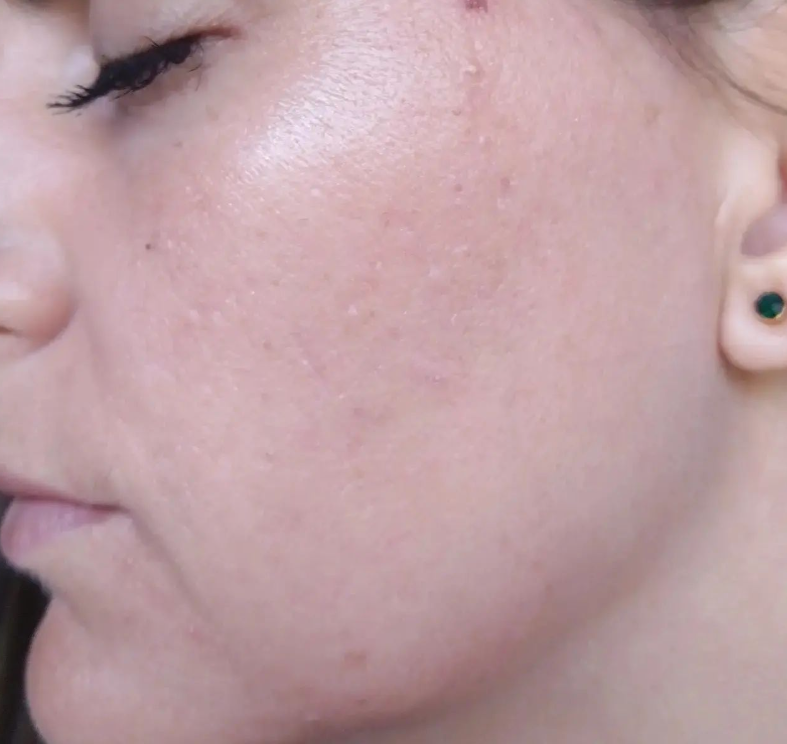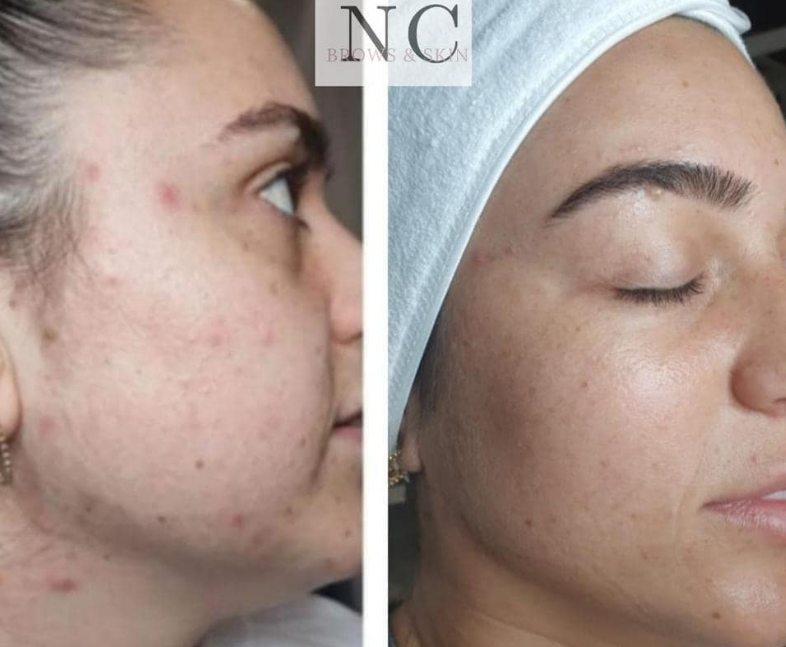Microdermabrasion vs chemical peel is a popular comparison made by those looking to enhance the appearance of their skin. These treatments have grown in popularity due to their non-surgical nature and efficacy in addressing various skin issues.
Microdermabrasion exfoliates the top layer of skin using a diamond-tipped wand. Whereas chemical peels remove the top layer with a chemical solution. These treatments improve skin texture and tone, minimize fine lines and wrinkles, and increase the visibility of dark spots and acne scars.
What Is Microdermabrasion?
Microdermabrasion is a minimally invasive cosmetic treatment that removes the top layer of your skin to rejuvenate it. It is an epidermal resurfacing technique that first appeared in 1985. Since then, it has become popular as a non-surgical treatment for improving the look of your skin.
What Is Chemical Peel?
A chemical peel is a non-surgical cosmetic procedure that removes dead skin using a chemical solution, revealing a smoother and brighter complexion. The chemical solution is applied to the skin and kept on for a specific time, depending on the intensity of the solution and the desired outcomes. The resolution encourages the creation of new, healthy skin cells by forcing the top layer of skin to peel off.
Chemical peels are often used to deal with various skin issues, such as fine lines and wrinkles, acne scars, uneven skin tone, and UV damage. The treatment may adjust to an individual’s unique skin type and issues. Chemical solutions of varying strengths are available to accomplish varying amounts of exfoliation.
Difference Between Microdermabrasion And Chemical Peel
Both microdermabrasion and chemical peels are ways to get rid of dead skin cells and improve the texture and tone of the skin. But they are different in several ways.
- Method: Microdermabrasion physically removes the top layer of skin. While a chemical peel dissolves the outer layer of skin using a chemical solution.
- Treatment Depth: Microdermabrasion is a simple procedure that removes dead skin cells just the top layer of skin. While chemical peels may reach deeper into the layer of the skin.
- Results: Microdermabrasion can treat acne scars and blemishes, as well as enhance skin texture and minimize the appearance of fine lines and wrinkles. Chemical peels may provide dramatic outcomes, including reducing deep wrinkles, sun damage, and hyperpigmentation.
- Downtime: Chemical peels may take several days of recovery time, depending on the complexity of the procedure, but microdermabrasion usually does not require any downtime.

Microdermabrasion vs Chemical Peel For Acne
Chemical peel vs microdermabrasion are both effective acne treatments. Microdermabrasion can help in the removal of dead skin cells and the unclogging of pores, as well as the stimulation of collagen formation. A chemical peel can also help unclog pores and exfoliate the skin and reduce the irritation and redness that acne cause.
Microdermabrasion vs Chemical Peel For Sun Damage
Chemical peel vs microdermabrasion can help improve the look of sun-damaged skin. Microdermabrasion may enhance the removal of sun-damaged skin cells while stimulating collagen formation, enhancing skin texture and tone. Chemical peels can penetrate the skin to treat more severe UV damage, such as hyperpigmentation and deep wrinkles.
Microdermabrasion vs Chemical Peel For Dark Spots
Chemical peels are often more effective than microdermabrasion in treating dark patches, known as hyperpigmentation. Chemical peels can penetrate the skin to target melanin synthesis, resulting in dark patches. Superficial chemical peels using alpha hydroxy acids (AHAs) can also assist in exfoliating the top layer of skin, where hyperpigmentation is most noticeable.
Microdermabrasion may also help to improve the look of dark spots, although it may take multiple treatments to see significant improvements.
Chemical Peel vs Microdermabrasion For Wrinkles
Microdermabrasion and chemical peel can help minimize the appearance of fine lines and wrinkles, although chemical peel is usually more effective for deeper wrinkles. Chemical peels can penetrate deeper into the skin, stimulating collagen synthesis and improving skin suppleness, resulting in smoother, younger-looking skin. While microdermabrasion can promote collagen formation, it may take multiple sessions to see noticeable effects.
Chemical Peels vs Microdermabrasion Pros and Cons
Both microdermabrasion and chemical peels have pros and cons, and the best treatment for an individual will depend on their skin concerns and preferences.
Pros
- Microdermabrasion and chemical peel are non-surgical treatments that don’t require anesthetic or downtime, making them less invasive than other cosmetic procedures.
- After only one session, these treatments can significantly change skin texture, tone, and appearance.
- Microdermabrasion and chemical peels are typically safe for most skin types, including sensitive skin, since they may be suited to an individual’s unique crystal skin issues.
- These treatments can potentially reduce the appearance of acne scars while creating smoother and clearer skin.
- Microdermabrasion and chemical peels can increase collagen formation, improving skin suppleness and reducing the appearance of fine lines and wrinkles.
Cons
- Both treatments can induce temporary side effects like redness, dryness, and peeling. More significant side effects, such as infection or scarring, may happen in rare situations.
- Microdermabrasion and chemical peels can be effective in different ways, depending on the individual’s skin type and concerns, as well as the strength of the treatment.
- Although these treatments may provide immediate improvements, many sessions may be necessary for the best outcomes.
- Both treatments can make your skin more sensitive to the sun, so taking extra precautions, like using sunscreen and staying out of the sun for long periods after treatment is important.

Can You Get Microdermabrasion Or Chemical Peel At The Same Time?
It is possible to get a microdermabrasion and a chemical peel at the same time, but it is not recommended. When these two treatments are used together, they can be too harsh for the skin, making side effects like redness, peeling, and irritation more likely. It is best to wait at least a week or more between treatments to give the skin time to heal.
Microdermabrasion Or Chemical Peel Which Is Better?
The decision between microdermabrasion and chemical peel is ultimately determined by an individual’s skin type, concerns, and preferences. Both treatments may improve skin texture, tone, and appearance, but they function differently and have distinct advantages and disadvantages. Microdermabrasion may be a better option for those with sensitive skin or who desire a less harsh treatment with less downtime.
Chemical deep peels may be a preferable alternative for those who have more serious skin problems or want more dramatic results. Nevertheless, it is important to get the advice of a skincare professional to decide which treatment is most suitable for your unique skin conditions and preferences.

Cost Of Microdermabrasion vs Chemical Peel
The cost of microdermabrasion and chemical peels varies according to location, provider, and kind of treatment. Microdermabrasion is often less costly than chemical peeling, having prices ranging from $75 to $200 for each session. Chemical peel treatments may cost anywhere from $150 to $3,000, depending on the intensity of the treatment and the provider.
Main Takeaway
Microdermabrasion and chemical peels are effective procedures for improving skin texture and tone, reducing the appearance of fine lines and wrinkles, and addressing various skin issues. Although they vary in how they function, the results they provide, and the types of skin issues they are most suited for, both treatments may successfully improve skin look.
FAQs
1. How Long Do The Effects Of Microdermabrasion And Chemical Peel Treatments Last?
The effects of microdermabrasion and chemical peel treatments usually last from a few weeks to several months, depending on the person’s skin type and the specific treatment. Microdermabrasion results might last up to six months, whereas types of chemical peel outcomes can last up to a year.
Regular treatments are necessary to preserve the outcomes. Follow the right skin care routines to get the most out of these treatments and make them last longer.
2. Can I Undergo Microdermabrasion Or Chemical Peel Treatments If I Am Pregnant?
Microdermabrasion and chemical peel treatments are typically not advised for pregnant women. The chemicals and abrasives used in these treatments might enter the bloodstream and damage the growing baby. Moreover, hormonal changes during pregnancy might make skin more sensitive, raising the likelihood of severe treatment responses. It is preferable to postpone these procedures until after the pregnancy has ended and you have spoken with a medical practitioner.
3. Can Microdermabrasion Or Chemical Peel Treatments Help With Uneven Skin Tone?
Yes, both chemical peels and microdermabrasion can help uneven skin tone. Microdermabrasion is a non-invasive procedure using a diamond-tip wand to remove the top layer of dead skin cells. It can make the tone of the skin look better. Chemical peels remove the outer layers of skin using a chemical solution, which may help enhance skin tone by eliminating discoloration and hyperpigmentation.